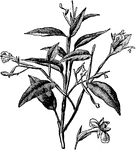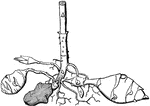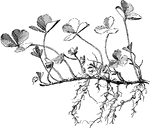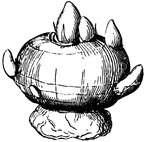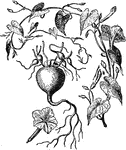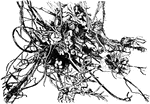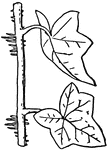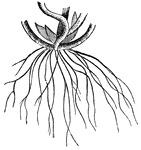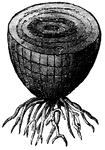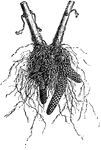
Root of the Achimene
In order to grow achimenes they have to be started and grown in stove heat until they flower. Roots…
Southern Adderstongue
"Adder's tongue fern (Ophioglossum vulgatum L.). R, runner or stolon." -Gager, 1916
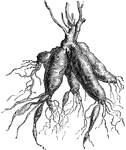
Roots of Ampelopsis Serjaniaefolia
The roots of ampelopsis serjaniaefolia look like tubers. This variety of ampelopsis grows in Japan.

Tubers of Anemone Coronaria
Anemone coronaria has tuberous roots. The flowers grow up to one foot tall from the roots
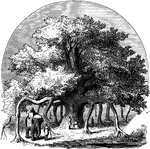
Banyan Tree
East Indian tree that puts out aerial shoots that grow down into the soil forming additional trunks.

Bean Seed Stages
"Successive stages in the life history of the bean seedling. AA, the surface of the ground; r, primary…
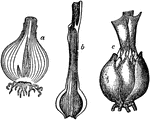
Various Bulbs
"a.-- Truncated bulb of onion; b.-- onion leaf dissected off; c.-- bulb of lily. Bulb, a modified leaf-bud,…
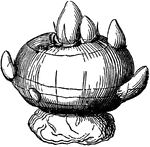
Corm of a Crocus
The investing sheaths or dead leaf-bases striped off. The faint cross-lines represent the scars, where…
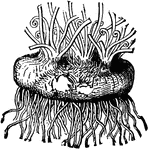
Corm of Cyclamen
Corm of Cyclamen. Roots from lower face, leaf-stalks and flower stalks from the upper.

Early Flax Seedling
Growth of Flax seedling from a stem with two leaves and a bud, to a stem with several leaves and stem…

Gentian
A genus of hardy plants, Gentians belong to the order Gentianaceae. They have a bitter taste, and one…

Geum Urbanum
Geum urbanum is a member of the genus Geum, a genus of hardy plants (Rosaceae). Not usually used decoratively,…
Root Grafting
A cion (smooth, one year old lenth of twig cut into a sex inch length) and root pictured, about to be…
!["When a grapevine is first set in a vineyard, it closely resembles the plant shown in [the image]. Such a rooted cutting may be one or two years old, the former being preferable in the majority of cases. The cane is cut back to two buds, and during the first season its shoots are allowed to lie prone upon the surface of the soil."—Government Printing Office, 1897](https://etc.usf.edu/clipart/79000/79014/79014_rootedgrape_mth.gif)
Rooted Grape Cutting
"When a grapevine is first set in a vineyard, it closely resembles the plant shown in [the image]. Such…
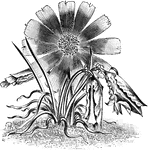
Lewisia Rediviva
Lewisia reiviva flowers are pink with a nearly white center. The flowers are about three to four inches…
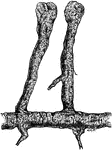
Aerating Roots of Swamp Mangrove
An image of laguncularia racemosa, or white mangrove. They grow in coastal areas of bays, lagoons, and…
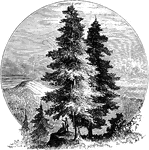
Pine Tree
Pines are native to most of the Northern Hemisphere. In North America, they range from Arctic south…

Potato Root Stages
"Regeneration at the leaf-base of potato leaves (Solanum tuberosum). a, roots formed; b, tuber-like…

Radish
View of a radish, illustrating the root-hairs, which absorb most of the water the plant needs.
Root
Roots aid in support and nutrition for the plant. This is a runner root which sends down roots into…
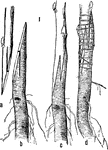
Root Grafting
"Root grafting in its different stages. a, Scion cut for insertion; b, stock prepared to receive the…
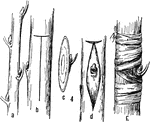
Budding Grafting
"Budding. a, Budstick; b, T-shaped cut in bark of stock; c, bud ready for insertion; d, stock with bud…

Cleft Grafting
"Cleft grafting (Herbaceous). a, Scion ready for insertion; b, stock; c, stock and scion unted; d, the…

Branching Root
"These roots are such as subdivide in the earth in a manner similar to the divisions of the stem, and…
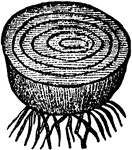
Bulb Root
"The bulb is a leaf-bud inclosed in scales or concentric layers, and is found either at the base of…
Carrot Root
Roots of the carrot are designed to absorb moisture and matter from soil, and to hold nutrients for…
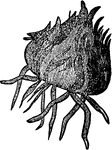
Cormus Root
"The Cormus is that variety which increases beneath the earth by development of buds in the axils of…
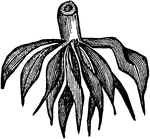
Fasciculated Root
"When the fibers of roots become enlarged by the deposition of starch, they form this variety of root."—Darby,…

